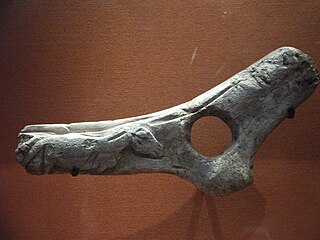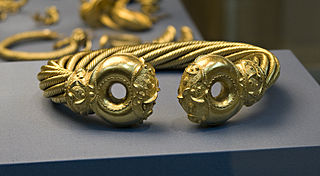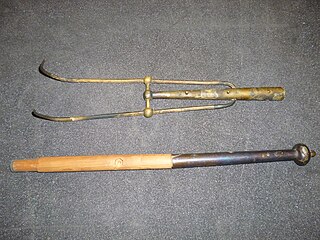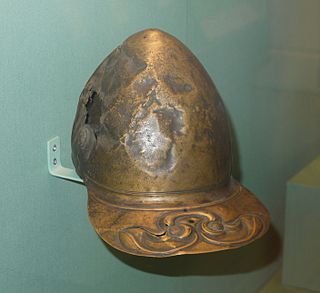 W
WThe Ain Sakhri Lovers figurine is a sculpture that was found in one of the Ain Sakhri caves near Bethlehem. The sculpture is considered to be 11,000 years old and to be the oldest known representation of two people engaged in sexual intercourse.
 W
WArcillera is a small village in the province of Zamora, Spain, close to the border with Portugal.
 W
WThe Basse Yutz Flagons are a pair of Iron Age ceremonial drinking vessels that date from the mid 5th century BCE. Since their discovery in ill-documented circumstances in the 1920s and their subsequent purchase by the British Museum, they have been described as "great masterpieces" that "combine most of the key features of early Celtic Art". They are in many respects very similar to the Dürrnberg Flagon found in Austria.
 W
WDating to the last Ice Age, this decorated fragment of a perforated antler baton was discovered in 1863 by Edouard Lartet and Henry Christy at the Abri de la Madeleine, an overhanging cliff situated near Tursac, in the Dordogne département and the Aquitaine Région of South-Western France. This is the type-site for the Magdalenian culture. It was bequeathed to the British Museum by Christy, and is now catalogued as Palart.310, but not normally on display. The baton is 16.6 cm long, 5.5 cm wide and 3 cm thick. The fragment is broken at both ends and is distinguished by a near-cylindrical section, which is interrupted on one side by a horse motif, and on the other side by three deeply cut grooves.
 W
WThe Battersea Shield is one of the most significant pieces of ancient Celtic art found in Britain. It is a sheet bronze covering of a wooden shield decorated in La Tène style. The shield is on display in the British Museum, and a replica is housed in the Museum of London.
 W
WThe Cordoba Treasure, or Tesoro de Córdoba in Spanish, is the name of a major Iron Age silver hoard found on the outskirts of the city of Córdoba, Spain in 1915. The entire treasure was purchased by the British Museum in 1932, where it has been on public display ever since.
 W
WThe Dowris Hoard is the name of an important Bronze Age hoard of over 200 objects found in Dowris, County Offaly, Ireland. Items from the deposit are currently split between two institutions: the National Museum of Ireland in Dublin and the British Museum in London.
 W
WThe Dunaverney Flesh-Hook is a sophisticated bronze artefact from Prehistoric Ireland, thought to be an item of ceremonial feasting gear, and a symbol of authority. It is believed it was used to remove chunks of meat from a stew in a large cauldron for serving. It dates to the Late Bronze Age, between 1050 and 900 BC. Since 1856, it has been in the British Museum in London.
 W
WThe Folkton Drums are a unique set of three decorated chalk objects in the shape of drums or solid cylinders dating from the Neolithic period. Found in a child's grave near the village of Folkton in northern England, they are now on loan to Stonehenge Visitor Centre from the British Museum. A similar object, the Lavant drum, was excavated in 1993 in Lavant, West Sussex.
 W
WThe Gray's Inn Lane Hand Axe is a pointed flint hand axe, found buried in gravel under Gray's Inn Lane, London, England, by pioneering archaeologist John Conyers in 1679, and now in the British Museum. The hand axe is a fine example from about 350,000 years ago, in the Lower Paleolithic period, but its main significance lies in the role it and the circumstances of its excavation played in the emerging understanding of early human history.
 W
WThe Great Torc from Snettisham or Snettisham Great Torc is a large, Iron Age electrum torc or neck-ring, the most spectacular object in the Snettisham Hoard of torcs and other metalwork found near the village of Snettisham in Norfolk, East Anglia. The perfectly intact torc is outstanding for its high level of craftsmanship and superb artistry. Soon after its discovery it was acquired by the British Museum.
 W
WThere are two notable Ipswich Hoards. The first was a hoard of Anglo-Saxon coins discovered in 1863. The second was a hoard of six Iron Age gold torcs that was discovered in 1968 and 1969. The latter hoard has been described as second only to the Snettisham Hoard in importance as a hoard from the Iron Age, and is held at the British Museum.
 W
WThe Kendrick's Cave Decorated Horse Jaw is one of the finest pieces of portable artwork dated to the end of the last Ice Age or Late Glacial period that has been found in Britain. Others in Britain include the Robin Hood Cave Horse and the Pin Hole Cave man. It is the oldest known piece of portable art from Wales.
 W
WLangdon Bay is a bay in east Kent, England. It is two miles east of the town of Dover, and is named after the nearby villages of Langdon, East Langdon and West Langdon. The cliffs around it are known as the Langdon Cliffs. A prominent zig-zag path down the cliff-face is visible from the sea and connects with the National Trust path by means of a step ladder. An additional means of exit from the beach being a return on foot to St Margaret's Bay. At the far western end is a restricted area of the Port of Dover, and occasionally walkers will be escorted out by the Dover Port Police.
 W
WThe Little Thetford flesh-hook is a late Bronze-Age artefact discovered in 1929 in Little Thetford, near Ely, Cambridgeshire, England. A flesh-hook is a metal hook with a long handle used to pull meat out of a pot or hides out of tan-pits. This particular find is one of 32 other such archaeologically significant finds, scatters, and excavations within 1 square mile (2.6 km2) of Little Thetford.
 W
WThe Lochar Moss Torc is an Iron Age brass torc or neck-ring found in Lochar Moss, near Dumfries in Scotland. It was found by chance in the early nineteenth century and was later donated to the British Museum.
 W
WThe Mammoth spear thrower is a spear thrower in the form of a mammoth, discovered at the "Montastruc rock shelter" in Bruniquel, France. It is from the late Magdalenian period and around 12,500 years old. It now forms part of the Christy Collection in the British Museum, and is normally on display in Room 2. Between 7 February – 26 May 2013 it was displayed in the exhibition at the British Museum Ice Age Art: Arrival of the Modern Mind.
 W
WThe Meyrick Helmet is an Iron Age bronze peaked helmet, with La Tène style decoration, that is held at the British Museum in London. It is one of only four Iron Age helmets to have been discovered in Britain, the other three being the more famous Waterloo Helmet, the Canterbury Helmet and the North Bersted Warrior helmet. Unlike the Waterloo Helmet, which bears two cone-shaped horns, the Meyrick Helmet is hornless and appears to be based on a Roman model. Vincent Megaw, emeritus professor of archaeology at the University of Leicester, has conjectured that the helmet may have belonged to a British auxiliary fighting in the Roman army during the campaigns against the Brigantes in AD 71–74.
 W
WThe Milton Keynes Hoard is a hoard of Bronze Age gold found in September 2000 in a field near Monkston in Milton Keynes, England. The hoard consisted of two torcs, three bracelets, and a fragment of bronze rod contained in a pottery vessel. The inclusion of pottery in the find enabled it to be dated to around 1150–800 BC.
 W
WThe Mold cape is a solid sheet-gold object dating from about 1900–1600 BC in the European Bronze Age. It was found at Mold in Flintshire, Wales, in 1833.
 W
WThe Montastruc decorated stone is an example of Ice Age art, now in the British Museum. A human figure that appears to be female has been scratched or engraved to decorate a fragment of limestone used as a lamp. The piece was excavated from Courbet Cave, Penne, Tarn, Midi-Pyrénées, France, on the northern bank of the river Aveyron, a tributary of the Tarn. It is dated to around 11,000 BCE, locally the Late Magdalenian culture during the Upper Palaeolithic, towards the end of the last Ice Age. It was excavated by Edouard Lartet and Henry Christy in 1863, and among other items bequeathed to CChristie's museum.
 W
WThe Mooghaun North Hoard or Great Clare Find is the name of an important Bronze Age hoard found at Mooghaun North, near Newmarket-on-Fergus in County Clare, Ireland. Considered one of the greatest Bronze Age hoards of gold ever found north of the Alps, unfortunately most of the treasure was melted down soon after its discovery. What remains of the hoard is currently split between the National Museum of Ireland in Dublin and the British Museum in London. It is no. 11 in A History of Ireland in 100 Objects.
 W
WThe Ourense Torcs are a pair of Iron Age gold torc neck rings found near Ourense in Northwest Spain in the 1950s. They were acquired by the British Museum in 1960.
 W
WThe Pinhole Cave Man or Pin Hole Cave Man is the common name for an engraving of a human figure on a woolly rhinoceros rib bone dating to the Upper Paleolithic that is now in the British Museum. In the 1920s, a woolly rhinoceros rib that was broken at both ends was found in Pin Hole Cave, Creswell Crags, Derbyshire, England.
 W
WRillaton Barrow is a Bronze Age round barrow in Cornwall, UK. The site is on the eastern flank of Bodmin Moor in the parish of Linkinhorne about four miles (6 km) north of Liskeard.
 W
WThe Ringlemere Gold Cup is a Bronze Age vessel found in the Ringlemere barrow near Sandwich in the English county of Kent in 2001.
 W
WThe Robin Hood Cave Horse is a fragment of rib engraved with a horse's head, discovered in 1876, in the Robin Hood Cave in Creswell Crags, Derbyshire. It is the only piece of Upper Paleolithic portable art showing an animal to have been found in Britain. It is now in the British Museum, but normally not on display. Between 7 February and 26 May 2013 it was displayed in the exhibition at the British Museum Ice Age Art: Arrival of the Modern Mind. A replica of the artifact is displayed at the Creswell Crags Museum.
 W
WThe Sedgeford Torc is a broken Iron Age gold torc found near the village of Sedgeford in Norfolk. The main part of the torc was found during harrowing of a field in 1965, and the missing terminal was found by Dr. Steve Hammond during fieldwork by the Sedgeford Historical and Archaeological Research Project in 2004. The torc is now displayed at the British Museum.
 W
WThe Snettisham Hoard or Snettisham Treasure is a series of discoveries of Iron Age precious metal, found in the Snettisham area of the English county of Norfolk between 1948 and 1973.
 W
WThe Sweet Track is an ancient trackway, or causeway, in the Somerset Levels, England, named after its finder, Ray Sweet. It was built in 3807 BC and is the second-oldest timber trackway discovered in the British Isles, dating to the Neolithic. It is now known that the Sweet Track was predominantly built along the course of an earlier structure, the Post Track.
 W
WThe Swimming Reindeer is the name given to a 13,000-year-old Magdalenian sculpture of two swimming reindeer conserved in the British Museum. The sculpture was made in what is now modern-day France by an unknown artist who carved the artwork from the tip of a mammoth tusk. The sculpture was found in two pieces in 1866, but it was not until the early 20th century that Abbé Henri Breuil realised that the two pieces fit together to form a single sculpture of two reindeer swimming nose-to-tail.
 W
WThe Wandsworth Shield is a circular bronze Iron Age shield boss or mount decorated in La Tène style which was found in the River Thames at Wandsworth in London sometime before 1849. Another incomplete bronze shield mount, sometimes called the Wandsworth Mask Shield was found at the same time. Both shield mounts are now held at the British Museum. The bold repoussé decoration on the Wandsworth Shield, comprising two birds with outstretched wings and long trailing tail feathers, has led Barry Cunliffe, Emeritus Professor of European Archaeology at the University of Oxford, to consider the shield to be "among the masterpieces of British Celtic art".
 W
WThe Waterloo Helmet is a pre-Roman Celtic bronze ceremonial horned helmet with repoussé decoration in the La Tène style, dating to circa 150–50 BC, that was found in 1868 in the River Thames by Waterloo Bridge in London, England. It is now on display at the British Museum in London.
 W
WThe Winchester Hoard is a hoard of Iron Age gold found in a field in the Winchester area of Hampshire, England, in 2000, by a retired florist and amateur metal detectorist, Kevan Halls. It was declared treasure and valued at £350,000—the highest reward granted under the Treasure Act 1996 at that time.
 W
WThe Wolverine pendant of Les Eyzies is a bone pendant decorated with an engraved drawing of a wolverine, probably from the cave of Les Eyzies, Dordogne, France. The pendant is from the late Magdalenian period and around 12,500 years old. It now forms part of the Christy Collection in the British Museum, where it is normally on display in Room 2. Between 7 February - 26 May 2013 it was displayed in the exhibition at the British Museum Ice Age Art: Arrival of the Modern Mind